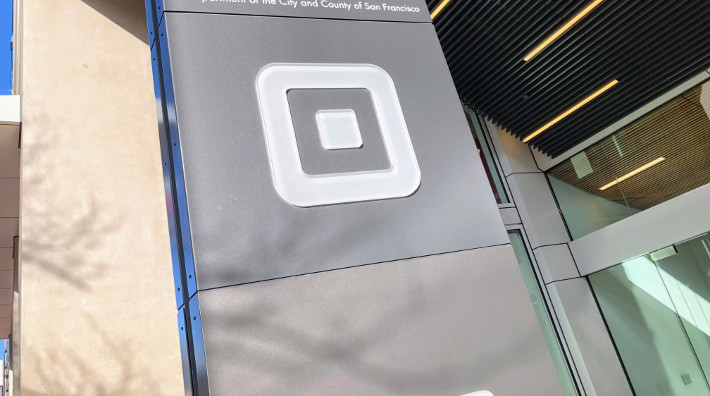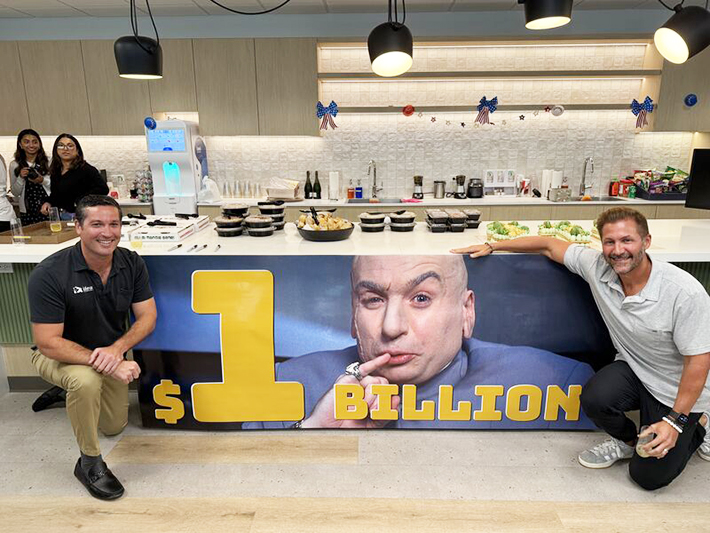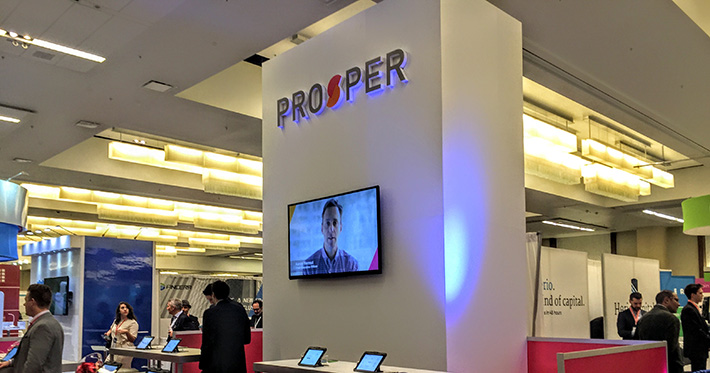Loans
‘Face-to-Face is a Must In This Industry’: How Julian Hernandez of Idea Financial Earned a Trophy Along The Way
November 24, 2025
“Face-to-face interactions are a must in our industry, and not only through conferences but even though we’re based out of Miami, I’m very familiar with the Long Island Railroad,” said Julian Hernandez, Director of Revenue at Idea Financial.
On multiple occasions, Hernandez has gone from New York City to eastern Long Island and then back again to meet with referral partners. It’s part of his job, meeting face-to-face with ISOs, and working with them to maximize the spread of Idea’s business line of credit products. He says through this experience he’s actually become “best buddies” with the LIRR.
“It’s good for morale, it’s good for relationships. It’s good not only for the reps internally on my end, but I’m sure for the reps on [the ISOs’] end to see and put a face to the lender that they’re always working with,” he said.
Hernandez will go wherever it’s necessary. Just last month that initiative placed him on the opposite side of the country, in a room full of ISOs and competitors that had gathered to play poker on the eve of the big B2B Finance Expo at the Wynn in Las Vegas. For Hernandez, who was born and raised in Colombia and only ever plays poker in a casual setting with friends, he had not gone in with any expectation of winning the friendly tournament. He wanted to network.
“That’s probably one of the main reasons why I wanted to join the tournament,” Hernandez said. “It’s just an opportunity for us, for anyone really that goes to the conference, to connect with either people that they know from the industry, or branch out or meet with new faces in an environment that isn’t so corporate.”
 As the cards were dealt and the hands played, Hernandez found himself at the final table of the night and walked away with 2nd place overall, a title that garnered him a trophy and a small prize.
As the cards were dealt and the hands played, Hernandez found himself at the final table of the night and walked away with 2nd place overall, a title that garnered him a trophy and a small prize.
While he was happy to earn the rank of #2, it was the social setting of it all that he felt was the best part.
“It’s more of a relaxed environment where people are just having a good time, playing a game, having a drink, and really just getting to know each other on a personal level,” Hernandez said. “That’s the best kind of way to make relationships, right? It’s kind of like when people always say the best kind of business is made on a golf course.”
But in the two days that followed at B2B Finance Expo, Hernandez and the Idea team that was there along with him were in business mode.
“97% of our business is through ISO channels and through all the relationships we’ve established with brokers in our industry, and we’re looking to expand that further,” Hernandez said, noting that there are big growth plans in the works for 2026.
 Idea’s line of credit is not like an MCA or the term loans commonly found around the industry. It’s a true revolving line. After every payment made, it replenishes the line. The process to get approved is quick and easy. Hernandez said that some brokers are shocked by how good it is and that larger businesses, ones that tend to be the most rate sensitive, find it very attractive.
Idea’s line of credit is not like an MCA or the term loans commonly found around the industry. It’s a true revolving line. After every payment made, it replenishes the line. The process to get approved is quick and easy. Hernandez said that some brokers are shocked by how good it is and that larger businesses, ones that tend to be the most rate sensitive, find it very attractive.
When deBanked first covered Idea Financial in 2019, Hernandez had not yet joined the company. He came on board the following year during covid and started in an entry level position. He’s since moved up the ranks and now oversees the entire sales and marketing department, which includes anything from ISO relations to marketing. He cites the team and the structure of how it operates as being the key to success. One of the things he first learned when he started was that Idea Financial was always looking to help businesses one way or another.
“I found my way to Idea Financial and have loved it ever since,” Hernandez said.
And while business and networking are important parts of the job, regardless of where that takes him, he is proud of how well he did in that poker tournament at B2B Finance Expo.
“I was happy with my 2nd place trophy,” Hernandez said. “It’s actually right there,” he exclaimed while pointing at it. “It’s back in my office!”
PayPal: Business Loan and Working Capital Originations of $600M in Q3
November 3, 2025PayPal originated approximately $600M in business loans and working capital loans in the third quarter. A financial institution makes the loans to their clients and PayPal purchases the receivables and services the portfolio. Under this basis the company has purchased $1.6B worth of receivables for the first nine months of 2025.
“The allowance for credit losses at September 30, 2025 for our merchant receivable portfolio was $163 million, an increase from $113 million at December 31, 2024,” PayPal stated in its earnings report. “The increase in allowance for credit losses was related to a decline in credit quality of merchant loans outstanding primarily from modifications in acceptable risk parameters in 2024, which included broadened eligibility. In the second quarter of 2025, we updated our expected credit loss model for all portfolios to utilize multiple economic scenarios rather than the single scenario previously utilized. These changes did not have a material impact on our allowance for credit losses in the period.”
FICOs Are 580 and Below, Repayment Rates Are Above 97%
September 23, 2025Block recently published an interview with Juan Hernandez, the company’s Head of Credit and Underwriting for its consumer lending divisions. Among the most interesting details Hernandez revealed is that 70% of Cash App Borrow customers have FICO scores of 580 or below, but their repayment rates are above 97%.
“That is only possible because our models are continuously learning from customer activity across Cash App and Afterpay,” Hernandez said of it.
Block sees income, deposits, spending patterns, savings behavior, and repayment behavior across the spectrum of its ecosystem and is able to use that data to make better predictions than legacy third party credit indicators.
 “The future of credit will be based on actual repayment ability, not outdated proxies,” Hernandez said. “With near real-time data and modern modeling, we can finally build a system that is more inclusive and safer than traditional credit scores that look backward, update slowly, and often misclassify people who are capable of managing credit.”
“The future of credit will be based on actual repayment ability, not outdated proxies,” Hernandez said. “With near real-time data and modern modeling, we can finally build a system that is more inclusive and safer than traditional credit scores that look backward, update slowly, and often misclassify people who are capable of managing credit.”
Block has made a name for itself in the lending space. Cash App Borrow originated $9B in loans in 2024 while its sister company Square Loans, which provides capital to small businesses, is the largest online small business lender that deBanked tracks. Square Loans originated $5.7B in 2024.
In March of this year Block received FDIC approval for its industrial bank, Square Financial Services Inc, to offer the Cash App Borrow loan product directly.
Idea Financial Hits Milestone, Will Still Fund in Texas
July 9, 2025
Idea Financial, a nationwide small business lender, recently surpassed $1 billion in funding since inception.
“This is a historic milestone,” said Larry Bassuk, president and co-founder of Idea Financial. “Only a few years ago, this company was just a concept with potential. Like many of the small businesses we serve, we started with confidence, grit, and the unyielding belief that we would succeed. Today, I can proudly announce that Idea Financial’s impact on the small business lending community is significant and positive. This moment belongs to our team, past and present, whose dedication has gotten us here.”
Because the company does term loans and lines of credit, it is not impacted by the recently-passed sales-based financing legislation in Texas and will continue to fund there like normal.
For background, Bassuk and Idea Financial CEO Justin Leto, actually started out in the legal profession as attorneys before taking a risk in small business lending. When deBanked first interviewed the duo in 2019, they said, “We’re not from the finance space, we’re not from the alternative lending space either, we came at this opportunity with a different approach.”
At that time, Idea had only funded $50 million since inception. Much of Idea’s growth since then can be attributed to their broker business, which it is still growing.
“Brokers and referral partners are critical to Idea’s success,” the company said. “While our borrowers are our clients, we also consider brokers and referral partners as clients by our team. We value their business and have made it a focus to develop close, mutually beneficial relationships with them.”
“We have been so fortunate to work with such a talented team, all of whom have contributed to the incredible growth of Idea,” said Leto. “We identified a problem with small business funding when we embarked on this journey, and we are so proud to have played a role in providing the solution that has fueled so many Main Street success stories.”
Prosper Marketplace Originated $2.2B in Consumer Loans in 2024
March 28, 2025 Prosper Marketplace, the last vestige of the P2P lending era, put up a repeat origination performance in 2024 vs 2023. The company originated $2.2B in consumer loans in 2024 and in 2023. That number had hit $3.3B in 2022 as part of the post-covid boom and had come in at only $1.9B in 2021.
Prosper Marketplace, the last vestige of the P2P lending era, put up a repeat origination performance in 2024 vs 2023. The company originated $2.2B in consumer loans in 2024 and in 2023. That number had hit $3.3B in 2022 as part of the post-covid boom and had come in at only $1.9B in 2021.
Only 7% of its originations in 2024 were from the “note channel” aka the peer-to-peer platform.
“We have incurred operating losses in prior years and may continue to incur net losses in the future,” the company disclosed in its annual report. “For the years ended December 31, 2024 and 2023, we incurred net losses of $54.1 million and $106.5 million, respectively. Additionally, from our inception through December 31, 2024, we have had an accumulated deficit of $644.2 million. We believe our liquidity needs for the next twelve months, and for the foreseeable future beyond that period, can be met through transaction fees, servicing fees, net interest income, other revenue, proceeds from sales of loans and securitizations, realized gains from the Credit Card portfolio and Cash and Cash Equivalents.”
Prosper used to compete against LendingClub as a peer-to-peer investment platform. LendingClub, however, discontinued its peer-to-peer business five years ago when it acquired Radius Bank.
Upstart: 91% of loans fully automated
February 19, 2025AI-based online consumer lending company Upstart just wrapped up a strong year, generating a tiny $2.8M net loss on $219M in revenue. Upstart was known for AI in the fintech industry before AI became the buzzword it is now. Ninety-one percent of the company’s loans in 2024 were fully automated with no human involvement, and 93% of instant approvals converted to funded loans.
Notably, a significant amount of their loan volume is generated by direct mail.
“Whenever our models get better, we tend to get more volume from partners, DM — direct mail converts better so that we can actually increase the amount of direct mail we send,” said CEO David Girouard.
While the company halted its earlier plans to add small business loans to its product mix, it still estimates the size of the market in its quarterly presentations. And according to that it’s an $895 billion market annually.
Analysts on the call liked what they heard about Upstart’s 2024 performance.
“2024 was a year of rapid quarter by quarter improvement for Upstart, and the fourth quarter clearly took the cake,” said Girouard. “Considering the weak environment we faced at the beginning of the year, we couldn’t have asked for a stronger finish. In Q4, our business grew dramatically across all our product categories on a sequential basis, delivered Adjusted EBITDA at levels not seen since the first quarter of 2022, and came within a whisker of returning to GAAP profitability.”
Upstart Hit With Another Lawsuit
October 13, 2022A new lawsuit brought by a shareholder of Upstart is also being brought derivatively on behalf of Upstart. That’s because plaintiff alleges that the Directors of the company would otherwise have to sue themselves or the company’s executives for the damage caused, a highly unlikely course of action.
Plaintiff alleges the company or certain directors and executives violated Section 14(a) of the Exchange Act, breached fiduciary duties, were unjustly enriched, abused their control, grossly mismanaged the company, wasted corporate assets, and violated Section 10(b) and 21D of the Exchange Act.
Things are not exactly great in shareholder land. The company’s stock as of May 4th close was $93.57 and is now currently hovering around $24.49. The plunge began when the company released its poorly-received quarterly earnings on May 9th. For a long time, the company had asserted it was not a balance sheet lender, but a shift in economic conditions was causing that to change.
The unwelcome quarterly earnings report was coincidentally timed after Upstart CEO David Girouard had sold more than $200M worth of company stock in the previous 8 month span and co-founder and SVP Paul Gu sold $140M worth over nearly the same time period.
Then, in August, Girouard said, “In the last few months, lenders and institutional credit investors reacted more quickly and abruptly than we anticipated. Despite the fact that our bank partners have seen consistently strong credit performance, meaning portfolios performing at or above plan across quarterly cohorts, several of them have paused or reduced originations due to fear about the future of the economy.”
Plaintiff alleges that false and misleading statements allowed the stock price to be propped up while insiders sold their stock on material non-public information. The full complaint can be viewed here.
This lawsuit is separate from a securities class action filed earlier this year.
Got a Mantle, Bryant, or Mahomes Card? This Company Wants to Fund You
September 12, 2022 Last month, an anonymous bidder paid $12.6M for a 1952 mint condition Topps Mickey Mantle baseball card, the highest amount ever fetched for a piece of sports memorabilia at an auction. Understandably, the news electrified a fast growing market of collectors, traders, and financiers that predicted the next big asset class wasn’t just going to be real estate or crypto or NFTs, but physical sports trading cards.
Last month, an anonymous bidder paid $12.6M for a 1952 mint condition Topps Mickey Mantle baseball card, the highest amount ever fetched for a piece of sports memorabilia at an auction. Understandably, the news electrified a fast growing market of collectors, traders, and financiers that predicted the next big asset class wasn’t just going to be real estate or crypto or NFTs, but physical sports trading cards.
The value of the Mantle sale came as no surprise to one budding entrepreneur in South Florida. On Instagram, he’d been talking about Mantle cards for weeks, even going so far as to hold up another ’52 Topps Mantle card to the camera to promote what his company can do, which is provide quick cash advances to owners of valuable sports cards.
The entrepreneur’s name is Edward Siegel, CEO of Card Fi. Siegel’s no stranger to the alternative finance space because he spent about a decade in the MCA industry, most recently as the founder of Bitty Advance, which he sold in 2020. Since then, Siegel returned to his roots and early passion of his youth.
“I had a background in sports cards as a collector, you know as a kid, but then in my early twenties, I was promoting card shows at malls,” Siegel said. “I was heavily into the hobby, setting up the card shows and promoting them and doing player appearances where players come in and do an autograph appearance.”
That was back in the late 80s, early 90s, according to Siegel.
When Covid hit and he exited his most recent company, he noticed a massive resurgence in the sports trading card market. His next business ultimately became Card Fi, a company that will evaluate the market value of a card and make an advance against it. There’s obviously risk involved so they take possession of the card for the duration.
“We have to get a hold of these cards and we’re responsible for them and then we vault them in our in-house bank vault,” Siegel said. The cards are stored in a highly secure climate controlled environment. Card Fi shows the vault off frequently in its Instagram videos.
Such a business requires large amounts of capital so Siegel went searching for investors, a pursuit that led him to a unique place, an Instagram Live pitch competition hosted by famed CEO and reality TV star Marcus Lemonis. Siegel entered himself in as a contestant, knowing full well that the odds of even being chosen to present his business to Lemonis were about a million-to-one.
Somehow, he was called up to pitch.
“So [businesses] went on there during the quarantine and you pitched your business,” Siegel explained. “I went on there and I pitched it […] And he understood it and he thought it made sense.”
The moment eventually led to a deal with Lemonis’ company and Card Fi was on its way.
 Siegel, meanwhile, dispels the notion that the burgeoning trading card industry or his business hinges upon old vintage cards or that it’s a baseball-card-centric universe.
Siegel, meanwhile, dispels the notion that the burgeoning trading card industry or his business hinges upon old vintage cards or that it’s a baseball-card-centric universe.
“If we look at it, there’s two different markets, you have the modern card market [where] I would say it’s basketball [that leads the pack],” he said. “For the vintage card market it’s baseball.”
Football is huge as well, he explained. A Patrick Mahomes rookie card, for example, an NFL Quarterback that’s still currently playing, recently fetched $861,000. There are only one of five like it in the world, the scarcity playing a major role in the value. Meanwhile, a Justin Herbert rookie card, an NFL Quarterback who’s only in his third year was already receiving bids above $1 million at the time this story was being written.
“It really depends on the card itself,” Siegel explained. “Some players might be known for having better careers but then you have cards that have more scarcity to them. Something that’s a one of one or maybe a very low populated card and a graded PSA 10 could very well be worth more than a [Michael] Jordan rookie because it has scarcity in it.”
PSA refers to cards that have been verified as authentic and graded on the condition of the card itself. Ten is the highest level a card can receive. Card Fi will only work with graded cards to avoid any funny business when it comes to advancing funds based upon the value.
 Siegel explained that Card Fi’s average advance is about $40,000 – $50,000. The max right now is $500,000. There’s a big market for this type of funding it turns out because Card Fi’s much larger rival, PWCC, just raised $175 million to make similar offerings to sports card owners.
Siegel explained that Card Fi’s average advance is about $40,000 – $50,000. The max right now is $500,000. There’s a big market for this type of funding it turns out because Card Fi’s much larger rival, PWCC, just raised $175 million to make similar offerings to sports card owners.
“This financing benefits the market as loans and cash advances have become an increasingly asked-for offering among trading card collectors,” said Chad Fister, PWCC’s CFO in a story that originally appeared on Sportico. “Enabling our clients to access liquidity through a menu of capital offerings is key as trading cards continue to prove themselves to be a valuable tangible asset class.”
For Card Fi, customers that take an advance can track everything through an online portal, including details about their cards, payments, and balance.
“We want to note that we built a full-service automated underwriting and collection platform to where, whether it’s the customer or the broker, they can log into our system and put the description of the card into the system and it’s going to automatically underwrite it and price it out,” Siegel said.
That description sounded like something straight out of the fintech industry of his past, especially the component about brokers.
“Just like the MCA space, we have a whole partnership side, a broker side, where brokers can refer us customers just as an affiliate where they just send the info over,” Siegel said. Similarly, they can earn a commission if a transaction is completed, he explained.
In this industry, brands like Topps, Upper Deck, and Panini have become the bread and butter for Card Fi. Even though it’s all business for Siegel these days, he couldn’t help but mention a particular card he had a personal attachment to.
“My personal favorite card in my collection is the 1965 Topps Joe Namath rookie card,” Siegel said. “Of course being a die hard New York Jets fan, that has to be my favorite card.”





























